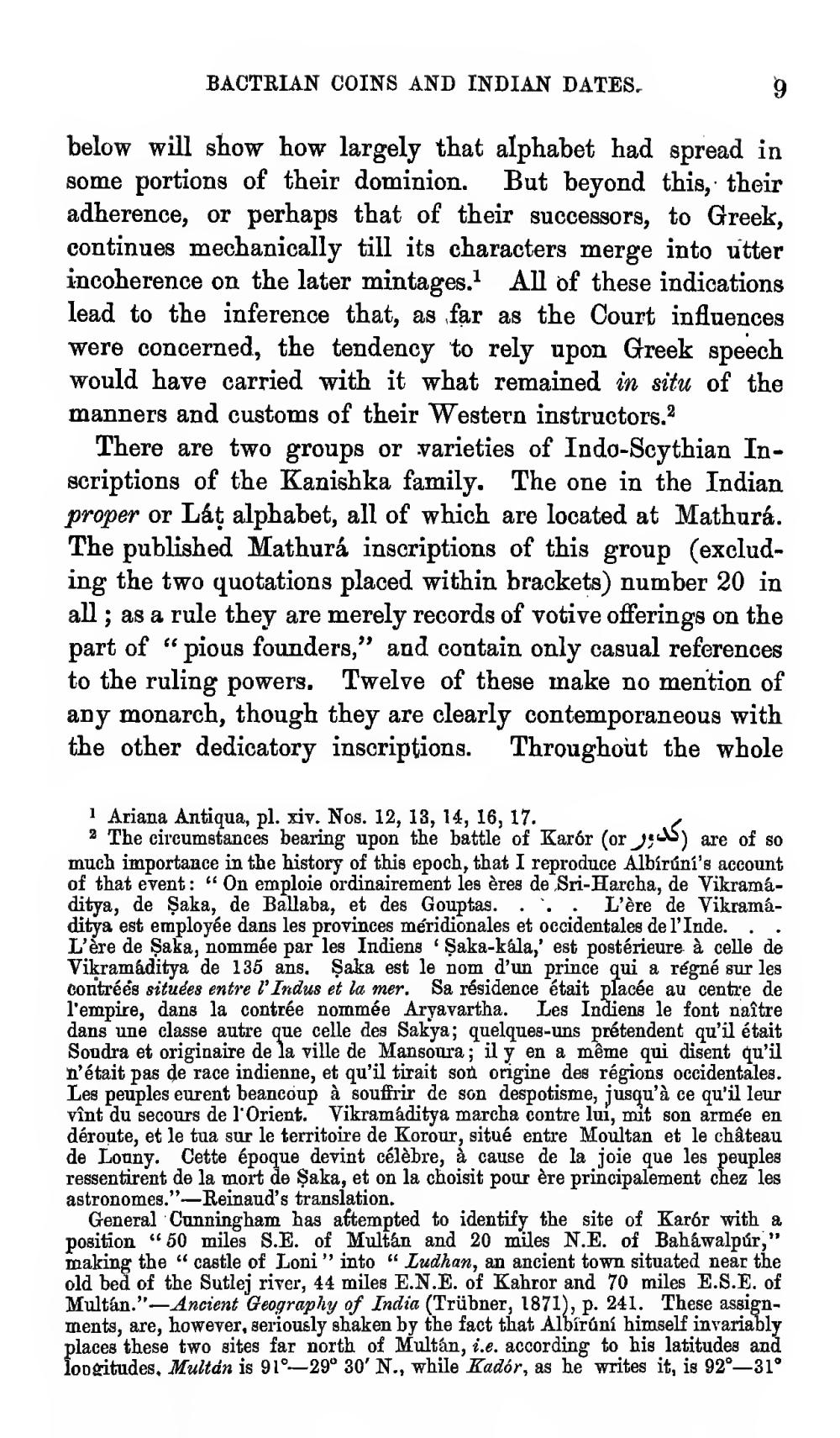________________
BACTRIAN COINS AND INDIAN DATES.
below will show how largely that alphabet had spread in some portions of their dominion. But beyond this, their adherence, or perhaps that of their successors, to Greek, continues mechanically till its characters merge into utter incoherence on the later mintages. All of these indications lead to the inference that, as far as the Court influences were concerned, the tendency to rely upon Greek speech would have carried with it what remained in situ of the manners and customs of their Western instructors.2
There are two groups or varieties of Indo-Scythian Inscriptions of the Kanishka family. The one in the Indian proper or Lát alphabet, all of which are located at Mathurá. The published Mathurá inscriptions of this group (excluding the two quotations placed within brackets) number 20 in all; as a rule they are merely records of votive offerings on the part of "pious founders," and contain only casual references to the ruling powers. Twelve of these make no mention of any monarch, though they are clearly contemporaneous with the other dedicatory inscriptions. Throughout the whole
1 Ariana
xiv. Nos. 12, 14, 16, 17.
(
2 The circumstances bearing upon the battle of Karór (or) are of so much importance in the history of this epoch, that I reproduce Albírúní's account of that event: "On emploie ordinairement les ères de Sri-Harcha, de Vikramáditya, de Şaka, de Ballaba, et des Gouptas. L'ère de Vikramáditya est employée dans les provinces méridionales et occidentales de l'Inde. L'ère de Şaka, nommée par les Indiens Şaka-kála,' est postérieure à celle de Vikramaditya de 135 ans. Şaka est le nom d'un prince qui a régné sur les contrées situées entre l'Indus et la mer. Sa résidence était placée au centre de l'empire, dans la contrée nommée Aryavartha. Les Indiens le font naître dans une classe autre que celle des Sakya; quelques-uns prétendent qu'il était Soudra et originaire de la ville de Mansoura; il y en a même qui disent qu'il n'était pas de race indienne, et qu'il tirait son origine des régions occidentales. Les peuples eurent beancoup à souffrir de son despotisme, jusqu'à ce qu'il leur vînt du secours de l'Orient. Vikramaditya marcha contre luí, mit son armée en déroute, et le tua sur le territoire de Korour, situé entre Moultan et le château de Louny. Cette époque devint célèbre, à cause de la joie que les peuples ressentirent de la mort de Saka, et on la choisit pour ère principalement chez les astronomes."-Reinaud's translation.
General Cunningham has attempted to identify the site of Karór with a position "50 miles S.E. of Multán and 20 miles N.E. of Bahawalpur," making the "castle of Loni" into "Ludhan, an ancient town situated near the old bed of the Sutlej river, 44 miles E.N.E. of Kahror and 70 miles E.S.E. of Multan."-Ancient Geography of India (Trübner, 1871), p. 241. These assignments, are, however, seriously shaken by the fact that Albírúní himself invariably places these two sites far north of Multán, i.e. according to his latitudes and longitudes, Multán is 91°-29° 30' N., while Kadór, as he writes it, is 92°-31°




